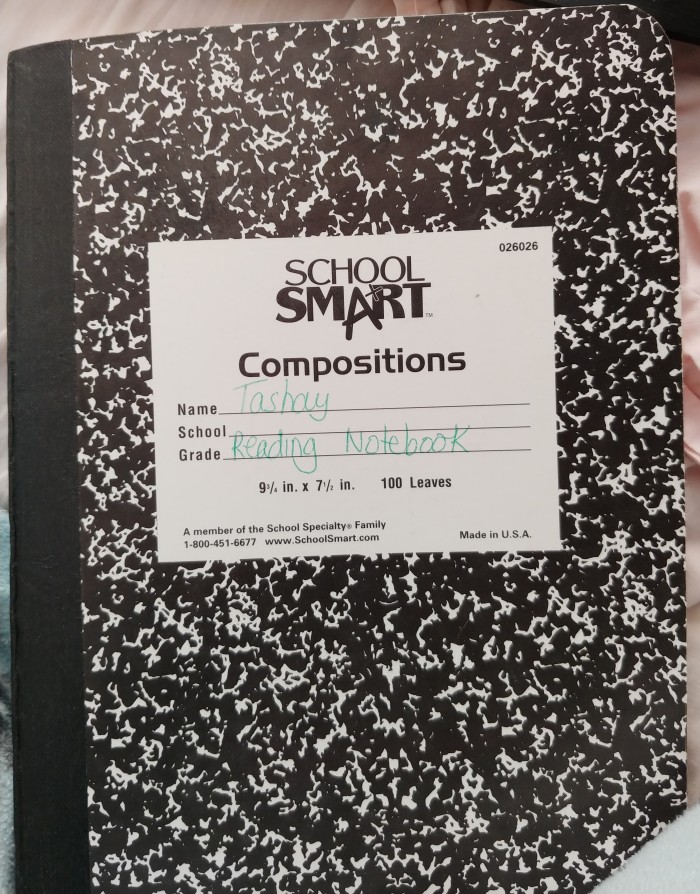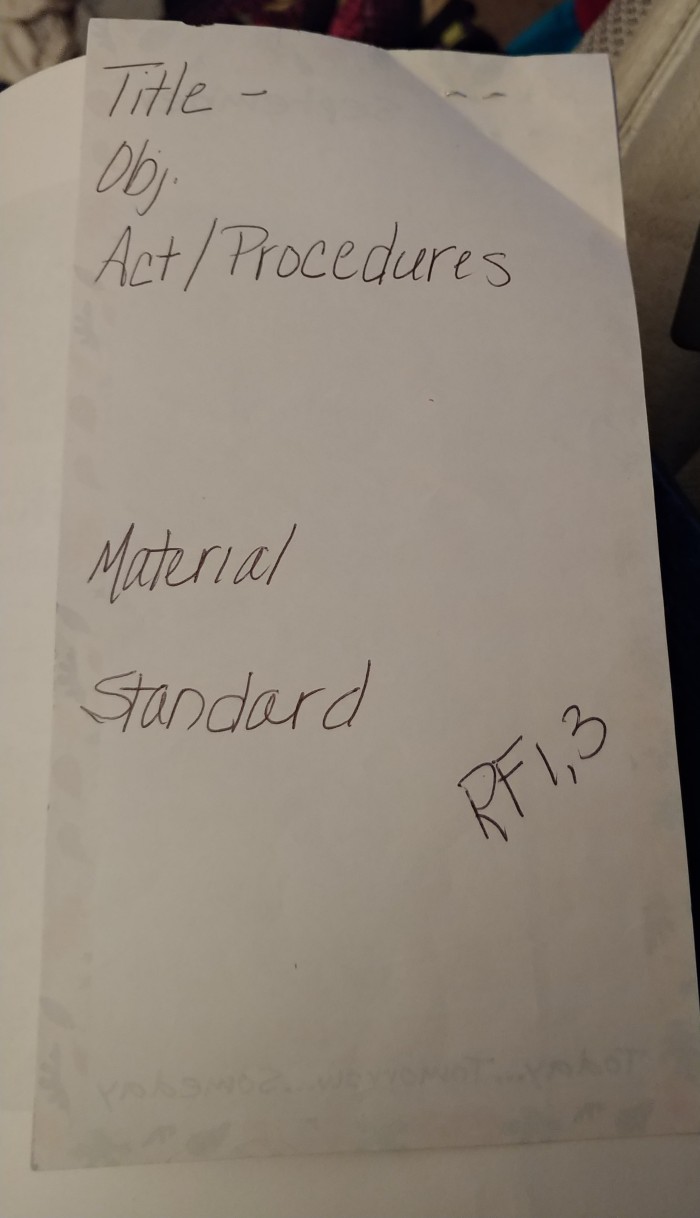The teacher plans for instruction that supports every student in meeting rigorous learning goals by drawing upon knowledge of content areas, curriculum, cross-disciplinary skills, pedagogy, as well as knowledge of learners and the community context.
There are a lot of things that are absolutely necessary to become a teacher. Standards tell us what characteristics we need to be an effective teacher. We have to understand our students and the content we are teaching to our students. Furthermore, we must create these lessons to teach the way our students learn. All these aspects to teaching require a lot of planning. Teachers must plan for the students they are going to teach, the content they are going to teach, and how they are going to teach the content to their students. Planning is not as simple as people think. It requires a lot of time and notetaking. Teachers must take their time to in planning out every single detail of a lesson. That is why they take notes.

Teaching requires a lot of notetaking. My first artifact is my teaching notebook. When I saw that Standard seven was about, I immediately knew that I wanted to this as an artifact. My cooperating teacher gave me this notebook so that I take notes on any feedback I get or anything she tells me about my teaching. She also gives me readings of books to help me teach better. At first, I did not take her advice. However, I started to learn that I am only failing myself by not taking the time to write everything down. I will write a short-form lesson plan. Then, I add notes to my notebook to help make the lesson more specific so that I know what I am doing. In the notebook, there is feedback and instructions written on how to teach math, writing, and grammar lessons. The notebook is not the only place I write down all my notes. I write them on a post-it sometimes on the lesson plan. I chose this artifact because it helps keep my thoughts together when it comes to teaching. Without it, I feel like I do not know what to do. When I have my notes right in front of me, I can remember everything I talked to my cooperating teacher and my supervisor. After all, there’s nothing wrong with a teacher having notes while teaching because it only helps him or her teach better. This is the advice my cooperating teacher gave me. This artifact is so important because it has taught me the importance of notetaking when planning. I have learned how important it is to take notes when planning so that you know what you are doing. Most teachers cannot do everything simply from pure memory. That’s why they write things down. At first, I did not think it was so necessary. Then, I started to see how important it is to write down ideas and feedback from others as well as important things from reading. When I get good feedback, I write it down in this notebook so that I can implement it in my lessons. Writing down notes only makes my lessons stronger.
This artifact shows how I understand this standard through personal experience. When I first got to my special education placement in my student teaching experience, I understood the importance of planning, but I needed to take it a step further. While I was in my general education placement, I taught effective lessons, but I was always running back to my lesson plan to remember what I wrote. However, I realize with this notebook, I do not need to keep running back to my long-form lesson plans because it is all written out for me. I can write short-form lesson plans with notes on them, so I am not spending so much time writing lesson plans, so I can focus on other aspects of my student teaching experience. It shows that I understand the importance of planning effective lessons and recording feedback or any other important information to make my lessons even more effective. With that said, this artifact makes me a better teaching candidate because it shows that I am taking initiative to make my lessons even more effective and listening to feedback from others to do so. It also shows that I plan my lessons with care, and I am not afraid to use a resource for help. After all, it only makes me a more effective teacher.

As I said before, planning for a teacher is a time-consuming process. Student teachers and full-time teachers alike have a lot of things going on in life that also require so much time. Because we do not want to spend so much time on planning, it is important we have a short-form lesson plan to summarize our lessons and take notes on, so we have more specific ideas on how to implement the lessons. My second artifact is the short-form lesson plan format my cooperating teacher gave me during the first week of school. This is just the title (what the teacher is teaching), objectives, procedure, materials, and standards. It is not meant to be as precise as the Rutgers lesson plan format. However, I would still revert to the long-form, step-by-step procedure to write my lessons. Then, my general education cooperating teacher told me her lesson plans were only two sentences because she knew anything could change at any time. I realized then that this lesson plan was not meant to be so precise when I taught a science lesson on the sun in which I completely changed up my way of teaching. I was originally supposed to teach out of the book, but I decided last minute to show a Brain Pop video because the book did not have a lot of information. It was then my cooperating teacher told me the reason her lesson plans are only two sentences. When I switched to special education, my cooperating teacher wanted me to break down how I would teach each step of my lessons (anticipatory set, process, guided practice, check for understanding, and closure). I thought I had found a way, but it was not much less time consuming than the long-form, step-by-step lesson plan. Then, I remembered when I observed how my general education teacher writes her lesson plans, and she only wrote the activities rather than the step-by-step procedure. I started writing my lesson plans that way because I did not want to take up so much time writing lesson plans. This artifact is significant because it reflects a short-form lesson plan that was meant to make my life easier. I was using it as a long-form lesson plan at first, but I started to realize that this little paper was actually meant to make my life easier, so I was not spending so much time writing the long-form lesson plans. I write the activities down first, then take specific notes later.
This artifact demonstrates my understanding of the standard because it shows that I am finding a way to be more effective in planning my lessons through the short-form lesson plan. As I said, it is so hard to focus with so much written on the long-form lesson plan, and it is so time consuming. You focus so much on the steps rather than the activities themselves. With that said, I feel like I am trying to find the best way to plan lessons to help my students understand content the best. I feel like this format is the best way to help me focus on making my lessons effective. It shows that I know the best way to help me plan effective instruction for my students. This artifact makes me an effective candidate because it shows that I am going through processes to help me plan best, and I have found it. Like the first artifact, this artifact was a recommendation from a teacher, and I am using it to help me become more effective in my teaching. It shows that I know how to take suggestions from other teachers and implement them myself to help me become a better teacher myself. It also shows that I am taking the necessary steps to see what is better for me. The planning I use that is most comfortable for me is what is going to help me become a better teaching candidate.
